Continuous CF/PA6 Composite Aircraft Window Frame Manufactured via a Novel Winding Compression Process
Abstract
:1. Introduction
2. Materials and Methods
2.1. Preparation of the Window Frame
2.1.1. Preparation of the CF/PA6-Impregnated Filaments
2.1.2. Winding Molding of the Window Frame Preform
2.1.3. Compression Molding of the Final Window Frame
2.1.4. Preparation of Chopped CF/Epoxy Composite Frame
2.2. Characterization
2.2.1. Fiber Content
- (1)
- Density method
- (2)
- Weight-loss method
- (3)
- Metallographic imaging method
2.2.2. Porosity
2.2.3. Mechanical Property
2.3. Simulation
2.3.1. Material Properties
2.3.2. Finite Element Models
2.3.3. Loading Scheme and Boundary Conditions
3. Results and Discussion
3.1. Performance of CF/PA6 Filaments
3.2. Optimization of Winding Compression Process
3.2.1. Process Parameter Optimization
3.2.2. Porosity
3.3. Window Frame Mechanical Properties
3.3.1. Tensile Experiments on Composite Window Frames
3.3.2. Performance Evaluation through Simulation Analysis
4. Conclusions
Author Contributions
Funding
Institutional Review Board Statement
Informed Consent Statement
Data Availability Statement
Acknowledgments
Conflicts of Interest
References
- Zhu, L.; Li, N.; Childs, P. Light-weighting in aerospace component and system design. Propuls. Power Res. 2018, 7, 103–119. [Google Scholar] [CrossRef]
- Parveez, B.; Kittur, M.; Badruddin, I.A.; Kamangar, S.; Hussien, M.; Umarfarooq, M. Scientific advancements in composite materials for aircraft applications: A review. Polymers 2022, 14, 5007. [Google Scholar] [CrossRef]
- Veiga, C.; Davim, J.P.; Loureiro, A. Properties and applications of titanium alloys: A brief review. Rev. Adv. Mater. Sci 2012, 32, 133–148. [Google Scholar]
- Sultana, S.; Asadi, A.; Colton, J.; Kalaitzidou, K. Composites made from CF prepreg trim waste tapes using sheet molding compounds (SMC) technology: Challenges and potential. Compos. Part A-Appl. Sci. Manuf. 2020, 134, 105906. [Google Scholar] [CrossRef]
- Zhang, J.; Lin, G.; Vaidya, U.; Wang, H. Past, present and future prospective of global carbon fibre composite developments and applications. Compos. Part B-Eng. 2023, 250, 110463. [Google Scholar] [CrossRef]
- Corbridge, D.M. Compression Moulding of Hybrid Carbon Fibre Composites for Structural Applications; University of Nottingham: Nottingham, UK, 2018. [Google Scholar]
- Labidi, A. Boeing 787 Dreamliner Represents Composites Revolution. Aviat. Knowl. Aerodyn. Meteorol. 2020, 3, 1–2. [Google Scholar]
- Qiao, Y.; Fring, L.D.; Pallaka, M.R.; Simmons, K.L. A review of the fabrication methods and mechanical behavior of continuous thermoplastic polymer fiber–thermoplastic polymer matrix composites. Polym. Compos. 2023, 44, 694–733. [Google Scholar] [CrossRef]
- Limaye, M.; Pradeep, S.A.; Kothari, A.; Savla, S.; Agha, A.; Pilla, S.; Li, G. Thermoforming process effects on structural performance of carbon fiber reinforced thermoplastic composite parts through a manufacturing to response pathway. Compos. Part B-Eng. 2022, 235, 109728. [Google Scholar] [CrossRef]
- Alshammari, B.A.; Alsuhybani, M.S.; Almushaikeh, A.M.; Alotaibi, B.M.; Alenad, A.M.; Alqahtani, N.B.; Alharbi, A.G. Comprehensive review of the properties and modifications of carbon fiber-reinforced thermoplastic composites. Polymers 2021, 13, 2474. [Google Scholar] [CrossRef]
- Zhao, H.; Gao, Z.; Zhai, D.; Zhao, G. Enhanced mechanical property of continuous carbon fiber/polyamide thermoplastic composites by combinational treatments of carbon fiber fabric. Compos. Commun. 2023, 38, 101508. [Google Scholar] [CrossRef]
- Jerome, P. Composite materials in the airbus A380-from history to future. In Proceedings of the 13th International Conference on Composite Materials (ICCM-13), Beijing, China, 25–29 June 2001. [Google Scholar]
- Kiss, P.; Stadlbauer, W.; Burgstaller, C.; Stadler, H.; Fehringer, S.; Haeuserer, F.; Archodoulaki, V.M. In-house recycling of carbon-and glass fibre-reinforced thermoplastic composite laminate waste into high-performance sheet materials. Compos. Part A-Appl. Sci. Manuf. 2020, 139, 106110. [Google Scholar] [CrossRef]
- Liu, Z.; Turner, T.A.; Wong, K.H.; Pickering, S.J. Development of high performance recycled carbon fibre composites with an advanced hydrodynamic fibre alignment process. J. Clean. Prod. 2021, 278, 123785. [Google Scholar] [CrossRef]
- Pakdel, E.; Kashi, S.; Varley, R.; Wang, X. Recent progress in recycling carbon fibre reinforced composites and dry carbon fibre wastes. Resour. Conserv. Recycl. 2021, 166, 105340. [Google Scholar] [CrossRef]
- Andrew, J.J.; Dhakal, H. Sustainable biobased composites for advanced applications: Recent trends and future opportunities–A critical review. Composites Part C Open Access 2022, 7, 100220. [Google Scholar] [CrossRef]
- Lopes, J.A.G.; Bacarreza, O.; Khodaei, Z.S. Design and analysis of composite window frame for a regional aircraft. J. Multiscale Model. 2020, 11, 2050006. [Google Scholar] [CrossRef]
- Zeyrek, B.; Aydogan, B.; Dilekcan, E.; Ozturk, F. Review of thermoplastic composites in aerospace industry. Int. J. Eng. Tech. Inf. 2022, 3, 1–6. [Google Scholar]
- Irisarri, F.-X.; Macquart, T.; Julien, C.; Espinassou, D. A novel design method for the fast and cost-effective manufacture of composite parts employing the Quilted Stratum Process. Compos. Part B-Eng. 2019, 158, 364–372. [Google Scholar] [CrossRef]
- Donough, M.J.; St John, N.A.; Philips, A.W.; Prusty, B.G. Process modelling of In-situ consolidated thermoplastic composite by automated fibre placement–A review. Compos. Part A-Appl. Sci. Manuf. 2022, 163, 107179. [Google Scholar] [CrossRef]
- Lamontia, M.A.; Funck, S.B.; Gruber, M.B.; Cope, R.D.; Waibel, B.J.; Gopez, N.M.; Pratte, J. Manufacturing flat and cylindrical laminates and built up structure using automated thermoplastic tape laying, fiber placement, and filament winding. Sampe J. 2003, 39, 30–43. [Google Scholar]
- Wang, B.; Wen, L.; Xiao, J.; Wang, S.; Ren, P.; Wang, L.; Zu, L.; Hou, X. Automated fiber placement path planning and analysis of pressure vessels. Materials 2023, 16, 6187. [Google Scholar] [CrossRef]
- Boon, Y.D.; Joshi, S.C.; Bhudolia, S.K. Filament winding and automated fiber placement with in situ consolidation for fiber reinforced thermoplastic polymer composites. Polymers 2021, 13, 1951. [Google Scholar] [CrossRef] [PubMed]
- Slange, T.K.; Grouve, W.J.; Warnet, L.L.; Wijskamp, S.; Akkerman, R. Towards the combination of automated lay-up and stamp forming for consolidation of tailored composite components. Compos. Part A-Appl. Sci. Manuf. 2019, 119, 165–175. [Google Scholar] [CrossRef]
- Summers, P.T.; Chen, Y.; Rippe, C.M.; Allen, B.; Mouritz, A.P.; Case, S.W.; Lattimer, B.Y. Overview of aluminum alloy mechanical properties during and after fires. Fire Sci. Rev. 2015, 4, 3. [Google Scholar] [CrossRef]
- ASTM D3039; Standard Test Method for Tensile Properties of Polymer Matrix Composite Materials. ASTM International: West Conshohocken, PA, USA, 2008.
- ASTM D6641; Standard Test Method for Compressive Properties of Polymer Matrix Composite Materials Using a Combined Loading Compression (CLC) Test Fixture. ASTM International: West Conshohocken, PA, USA, 2009.
- ASTM D7264; Standard Test Method for Flexural Properties of Polymer Matrix Composite Materials. ASTM International: West Conshohocken, PA, USA, 2007.
- ASTM D2344; Standard Test Method for Short-Beam Strength of Polymer Matrix Composite Materials and Their Laminates. ASTM International: West Conshohocken, PA, USA, 2016.
- ASTM D3518; Standard Test Method for In-Plane Shear Response of Polymer Matrix Composite Materials by Tensile Test of a ±45° Laminate. ASTM International: West Conshohocken, PA, USA, 2018.
- Sorrentino, L.; Anamateros, E.; Bellini, C.; Carrino, L.; Corcione, G.; Leone, A.; Paris, G. Robotic filament winding: An innovative technology to manufacture complex shape structural parts. Compos. Struct. 2019, 220, 699–707. [Google Scholar] [CrossRef]
- Göbert, A.; Deetman, A.; Rossi, A.; Weyhe, O.; Eversmann, P. 3DWoodWind: Robotic winding processes for material-efficient lightweight veneer components. Constr. Robot. 2022, 6, 39–55. [Google Scholar] [CrossRef]
- Arrabiyeh, P.A.; May, D.; Eckrich, M.; Dlugaj, A.M. An overview on current manufacturing technologies: Processing continuous rovings impregnated with thermoset resin. Polym. Compos. 2021, 42, 5630–5655. [Google Scholar] [CrossRef]
- Bascom, W.; Romans, J. Microvoids in glass-resin composites. Their origin and effect on composite strength. Ind. Eng. Chem. Prod. Res. Dev. 1968, 7, 172–178. [Google Scholar] [CrossRef]
- Stamopoulos, A.; Tserpes, K.; Prucha, P.; Vavrik, D. Evaluation of porosity effects on the mechanical properties of carbon fiber-reinforced plastic unidirectional laminates by X-ray computed tomography and mechanical testing. J. Compos. Mater. 2016, 50, 2087–2098. [Google Scholar] [CrossRef]
- Rengaraj, K. Void Growth Mitigation in High Heating Rate Out-of-Autoclave Processing of Composites; University of Nottingham: Nottingham, UK, 2016. [Google Scholar]
- Birt, E.A.; Smith, R.A. A review of NDE methods for porosity measurement in fibre-reinforced polymer composites. Insight-Non-Destr. Test. Cond. Monit. 2004, 46, 681–686. [Google Scholar] [CrossRef]
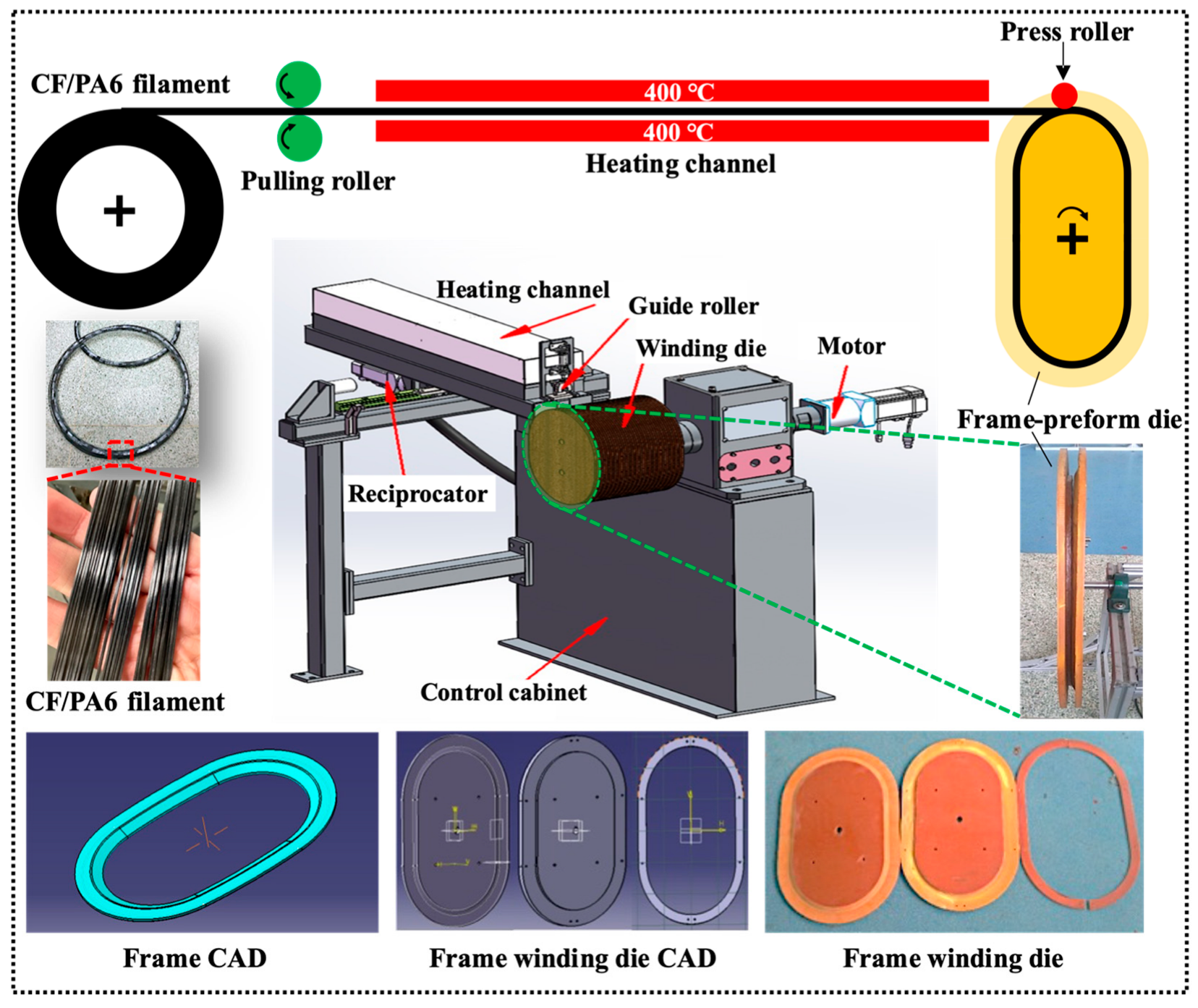
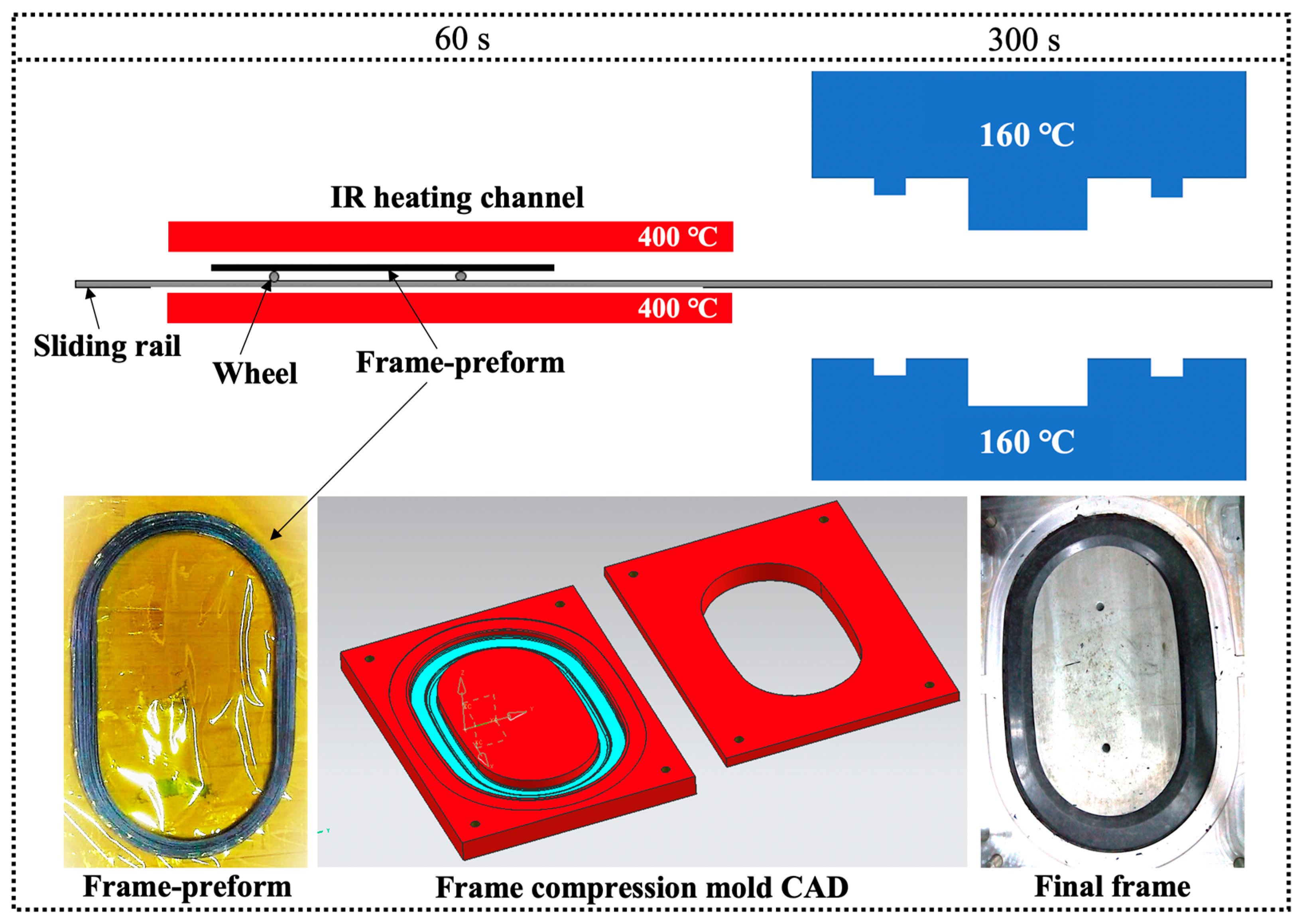

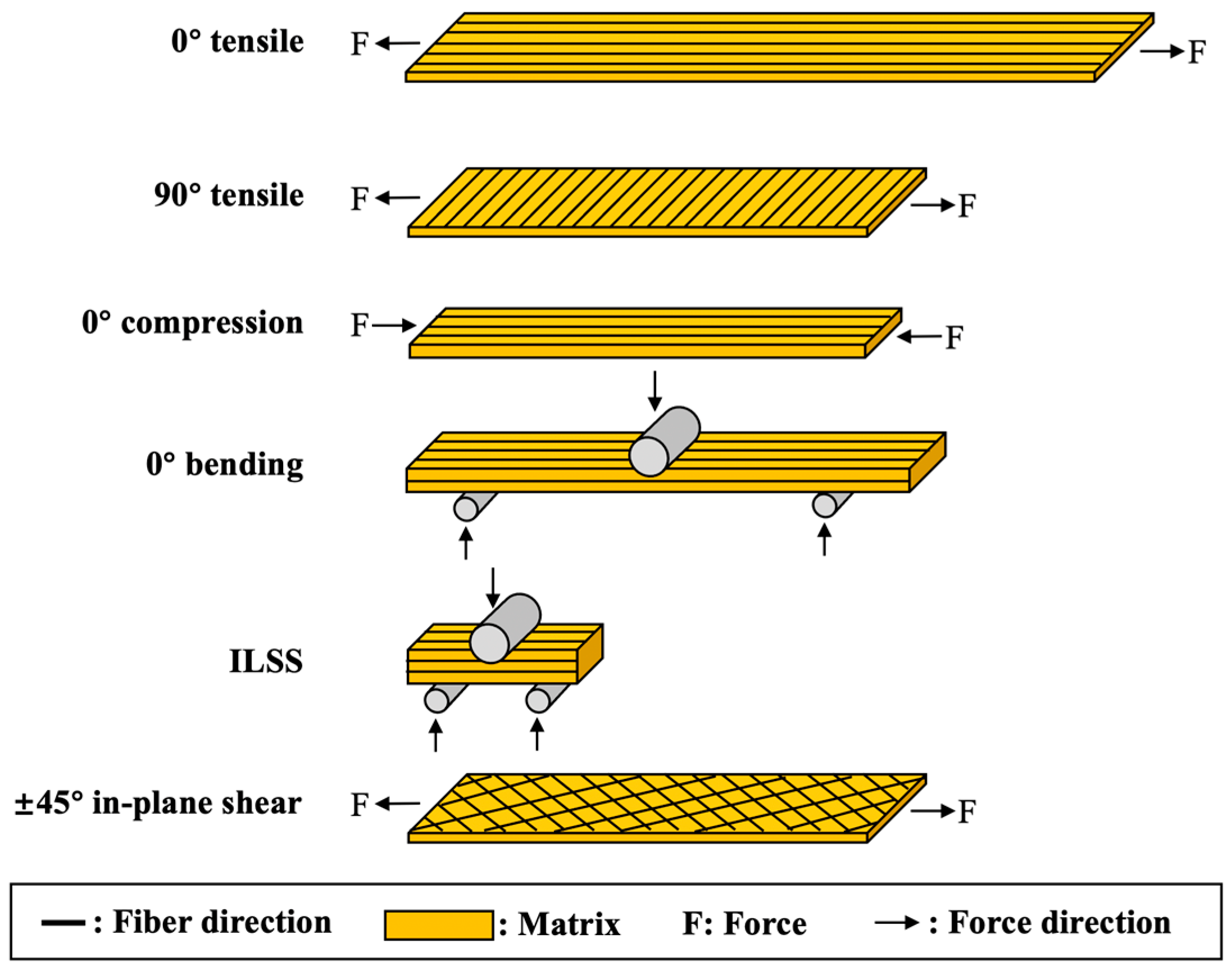
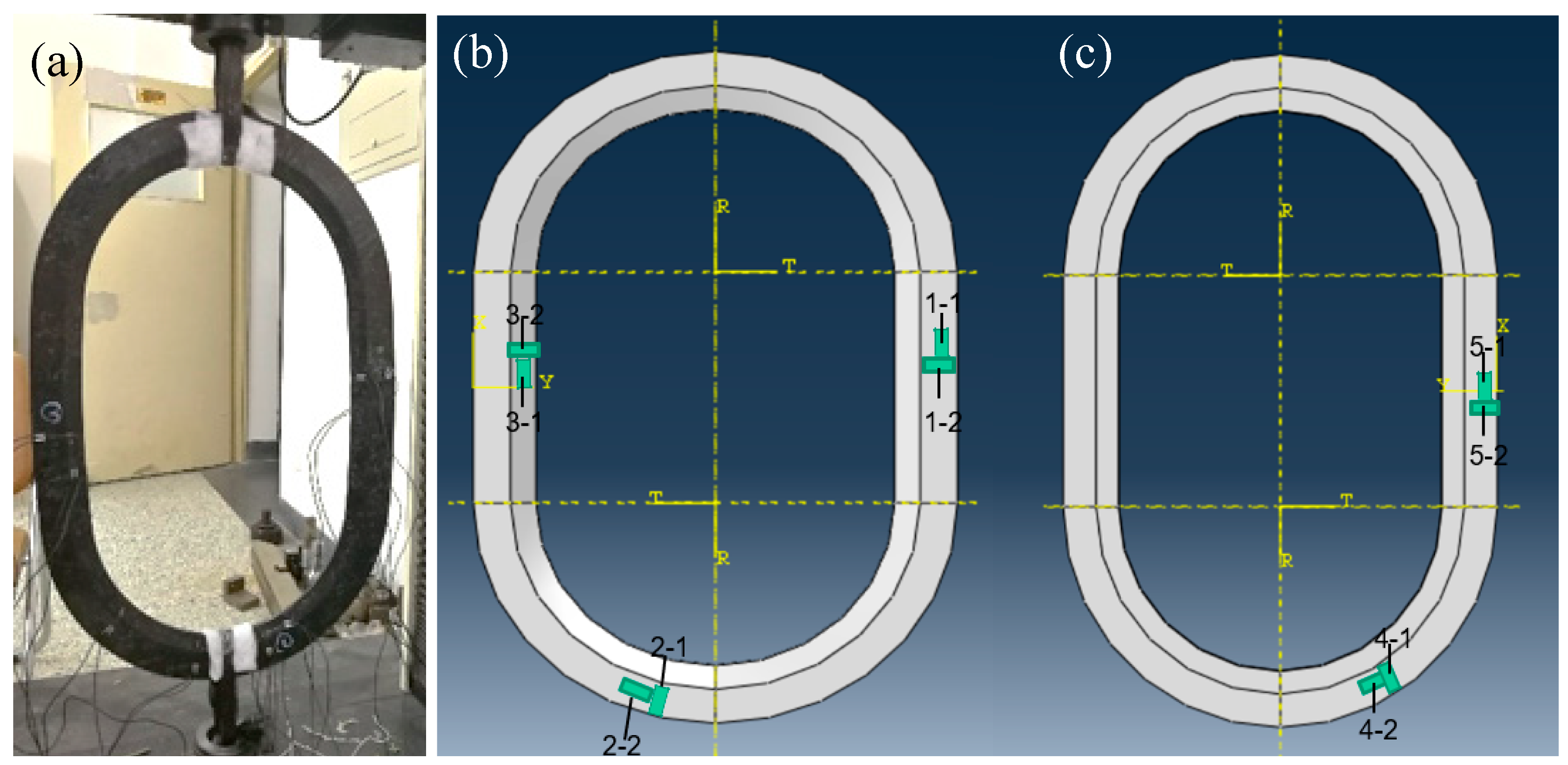
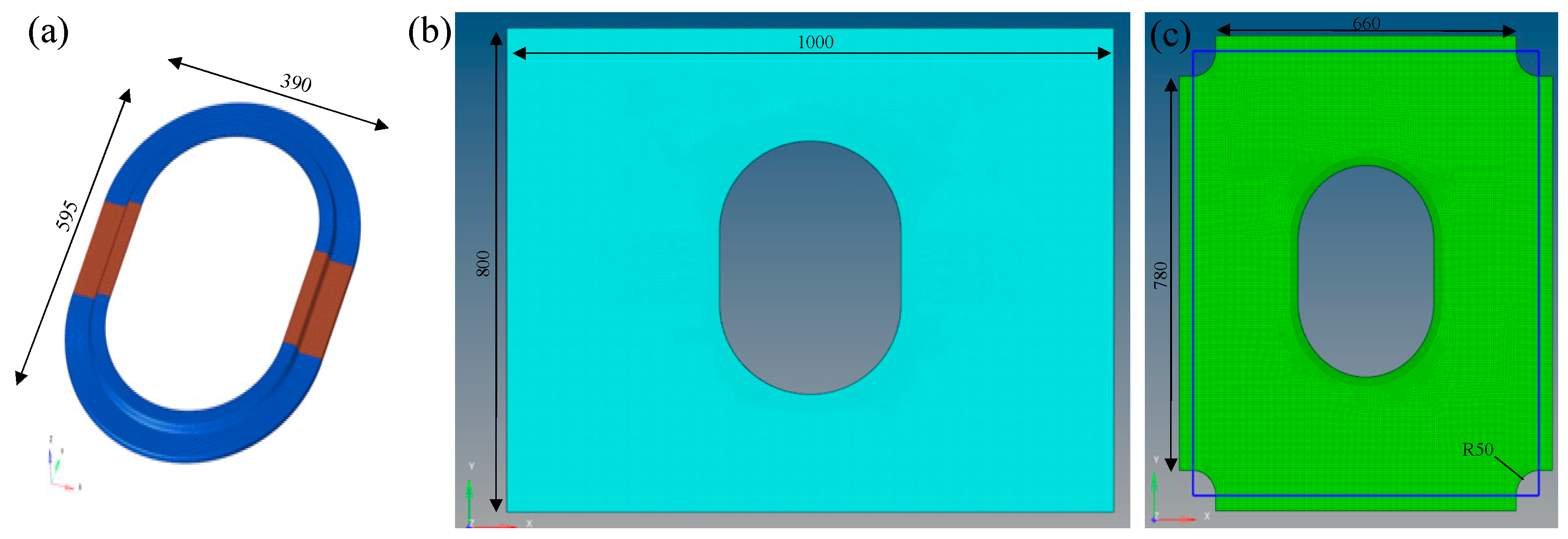



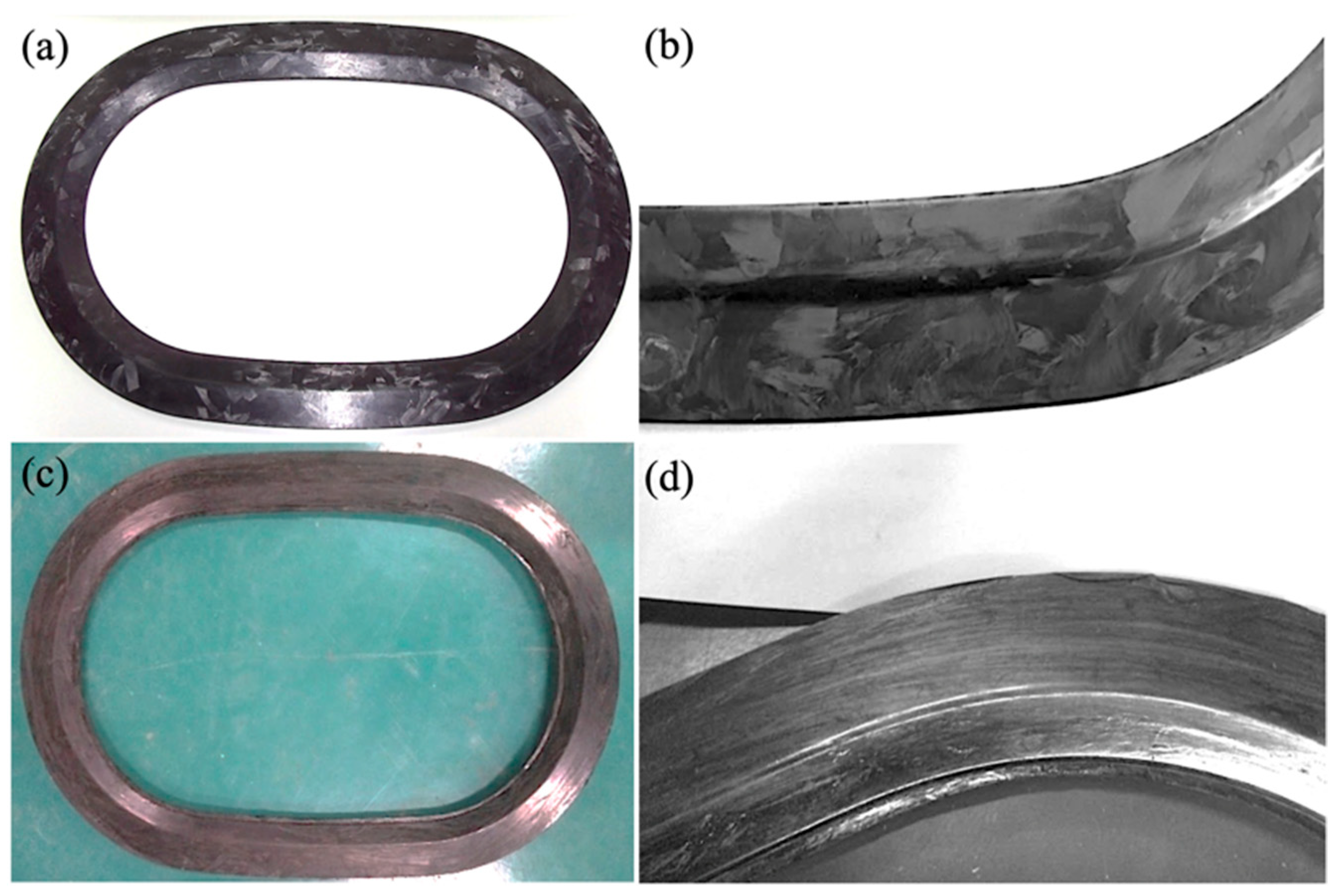
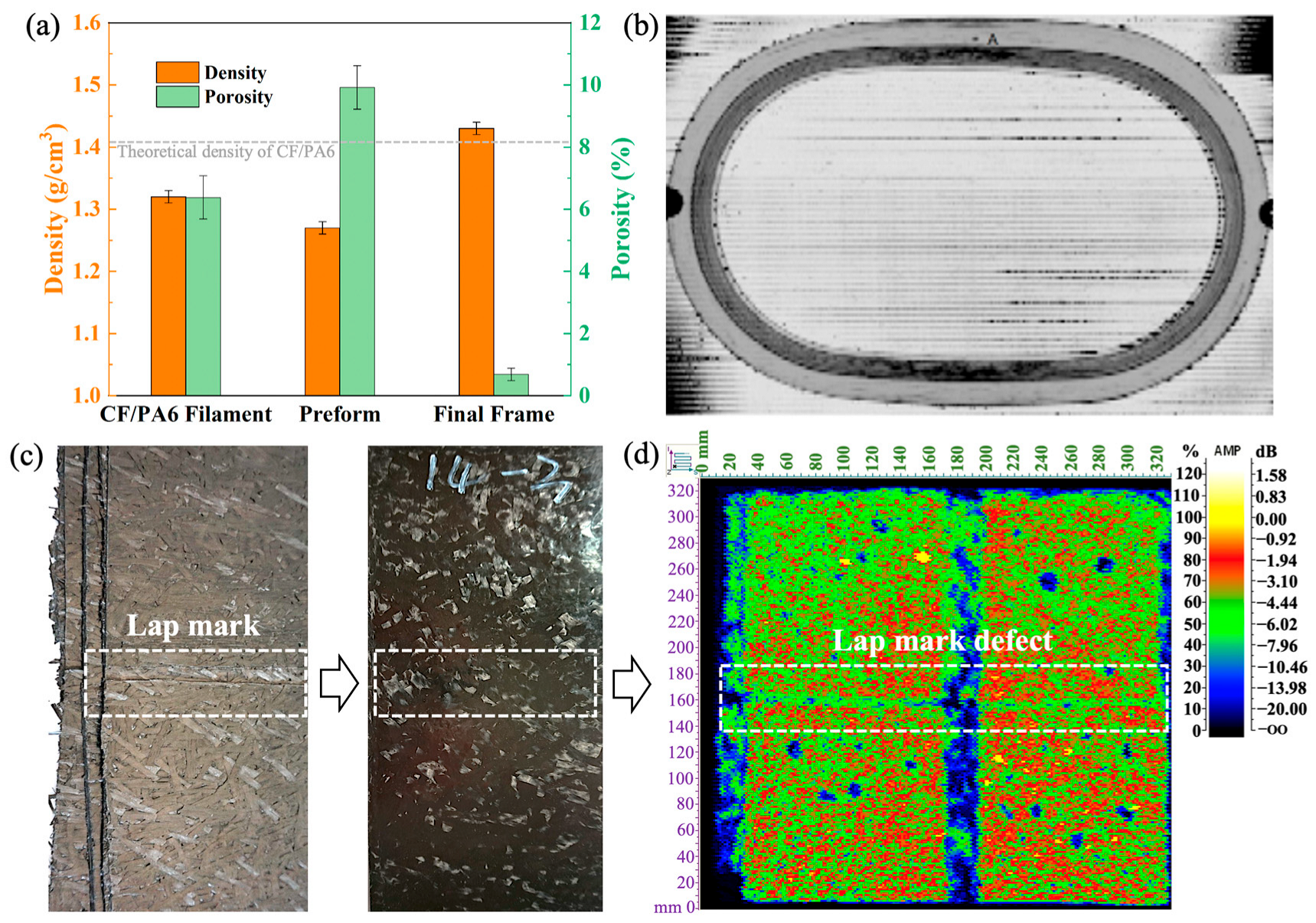
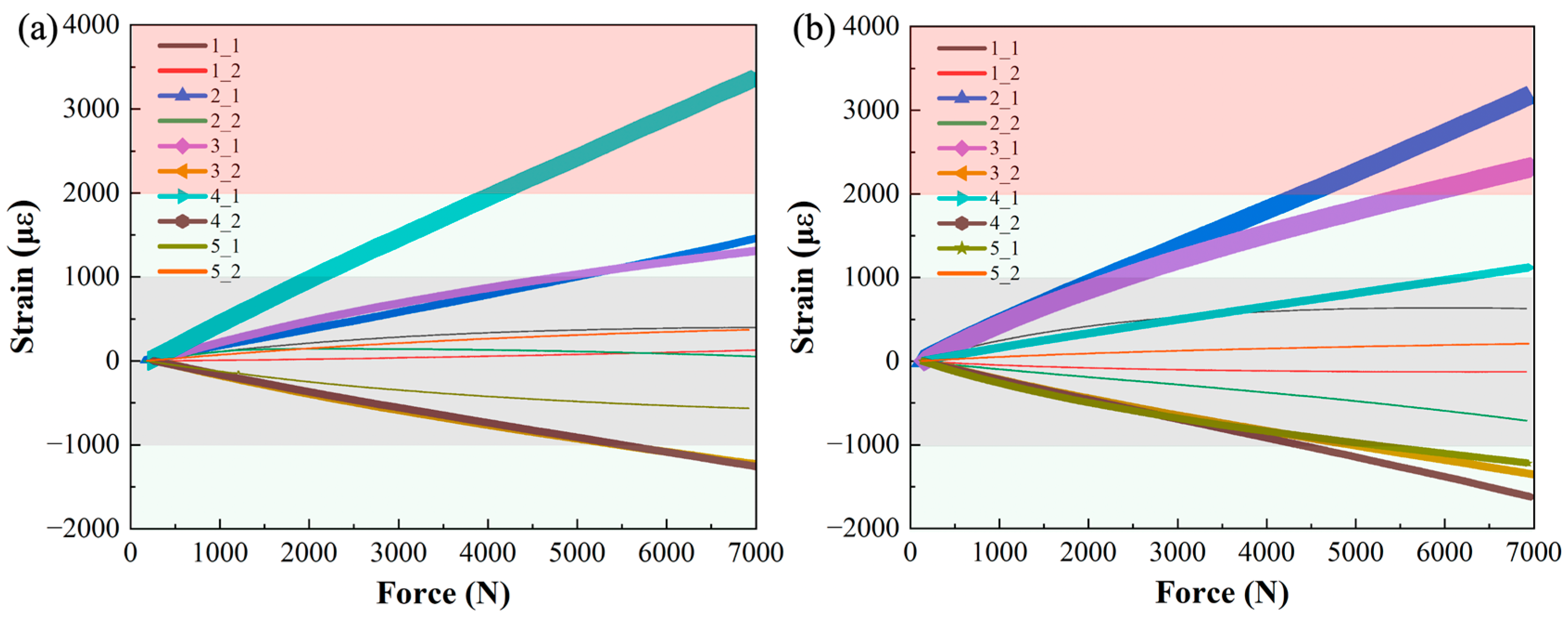
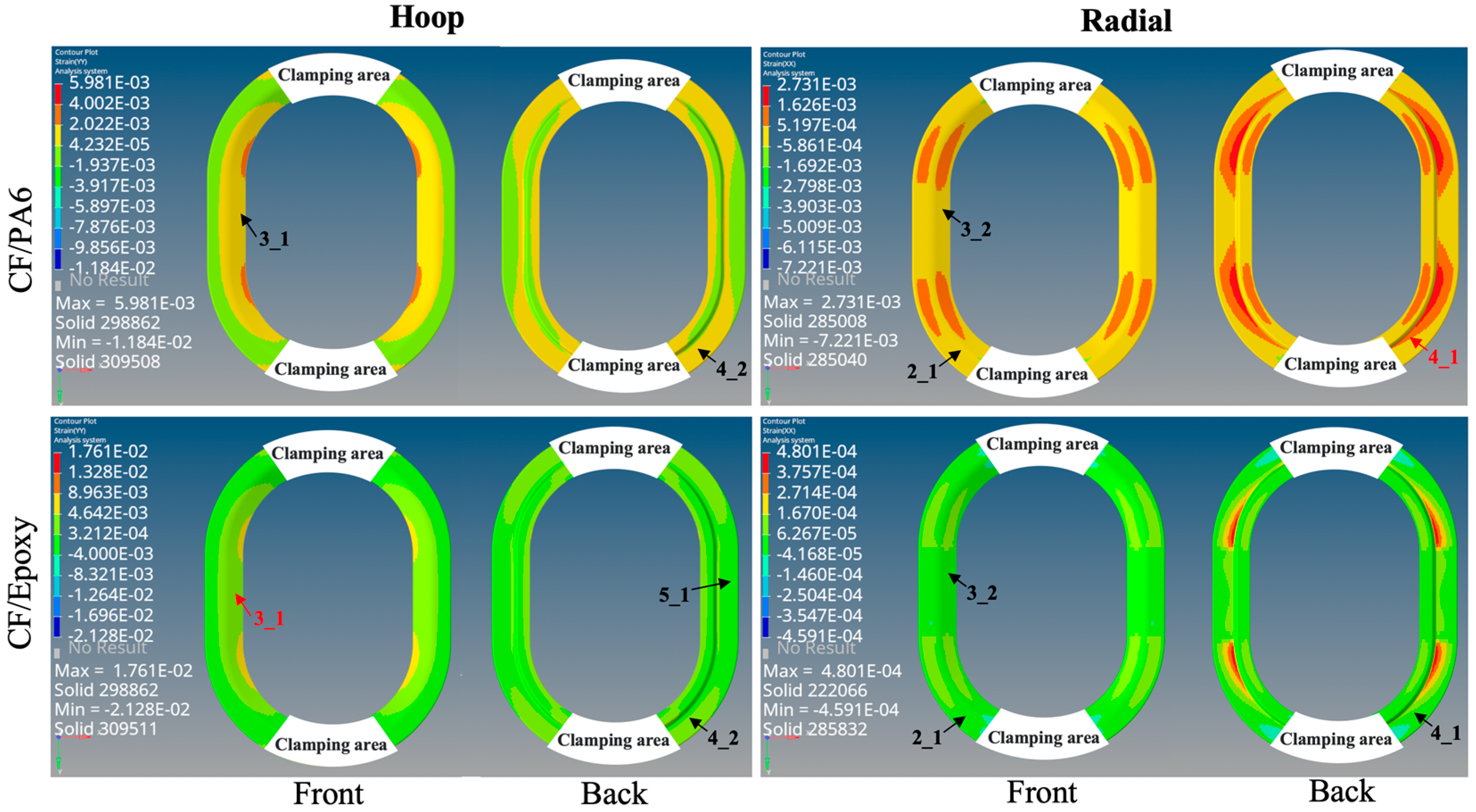
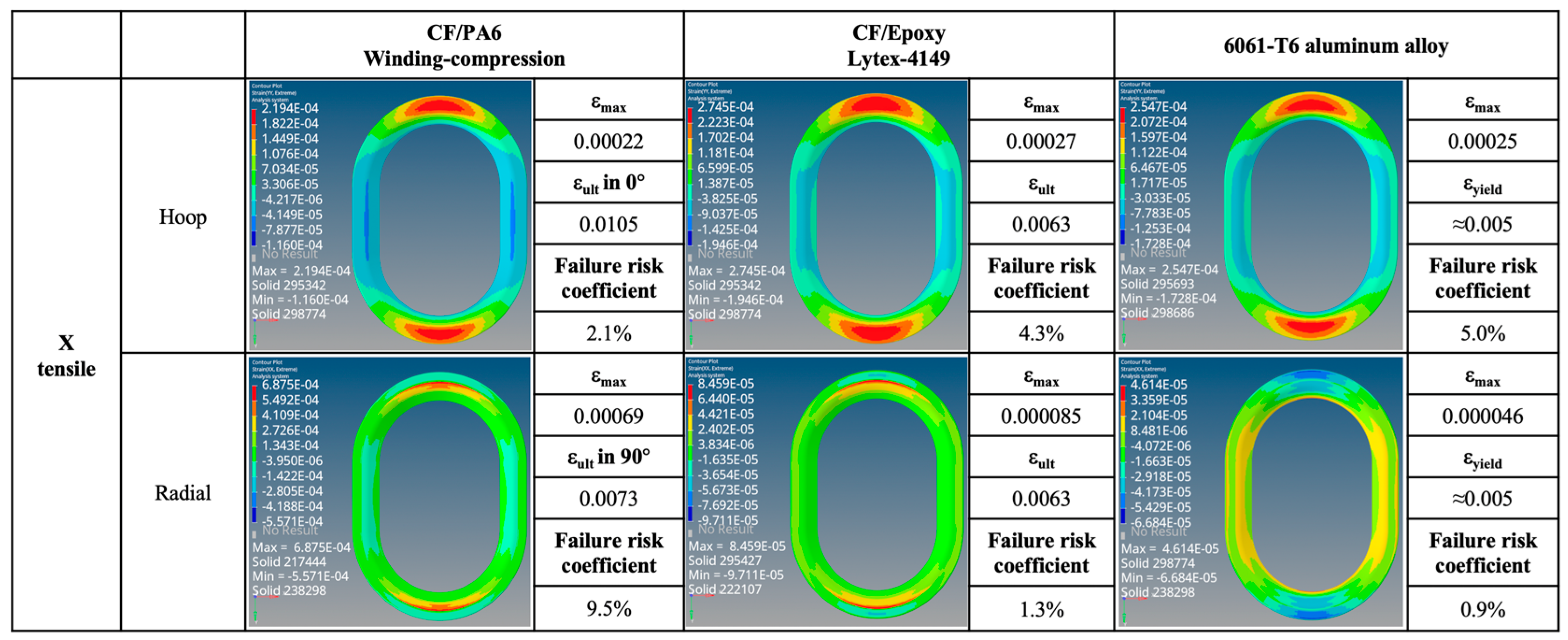
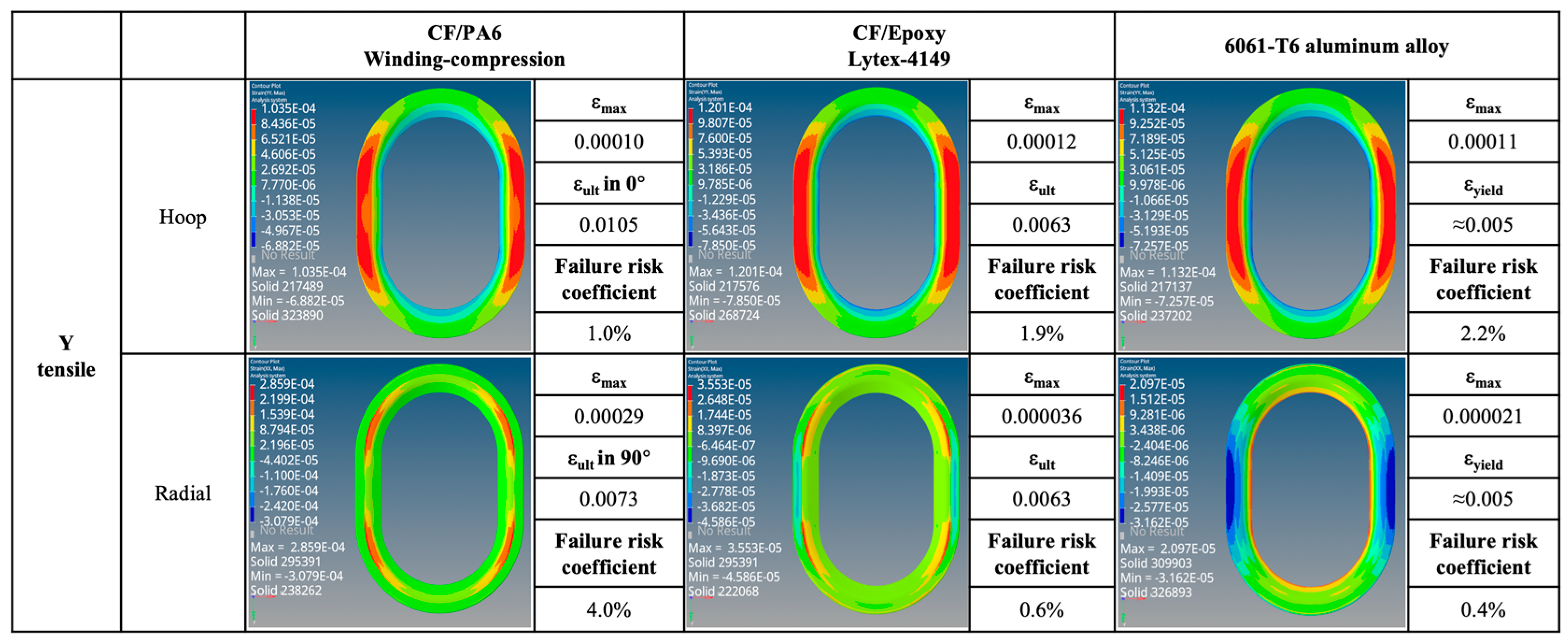
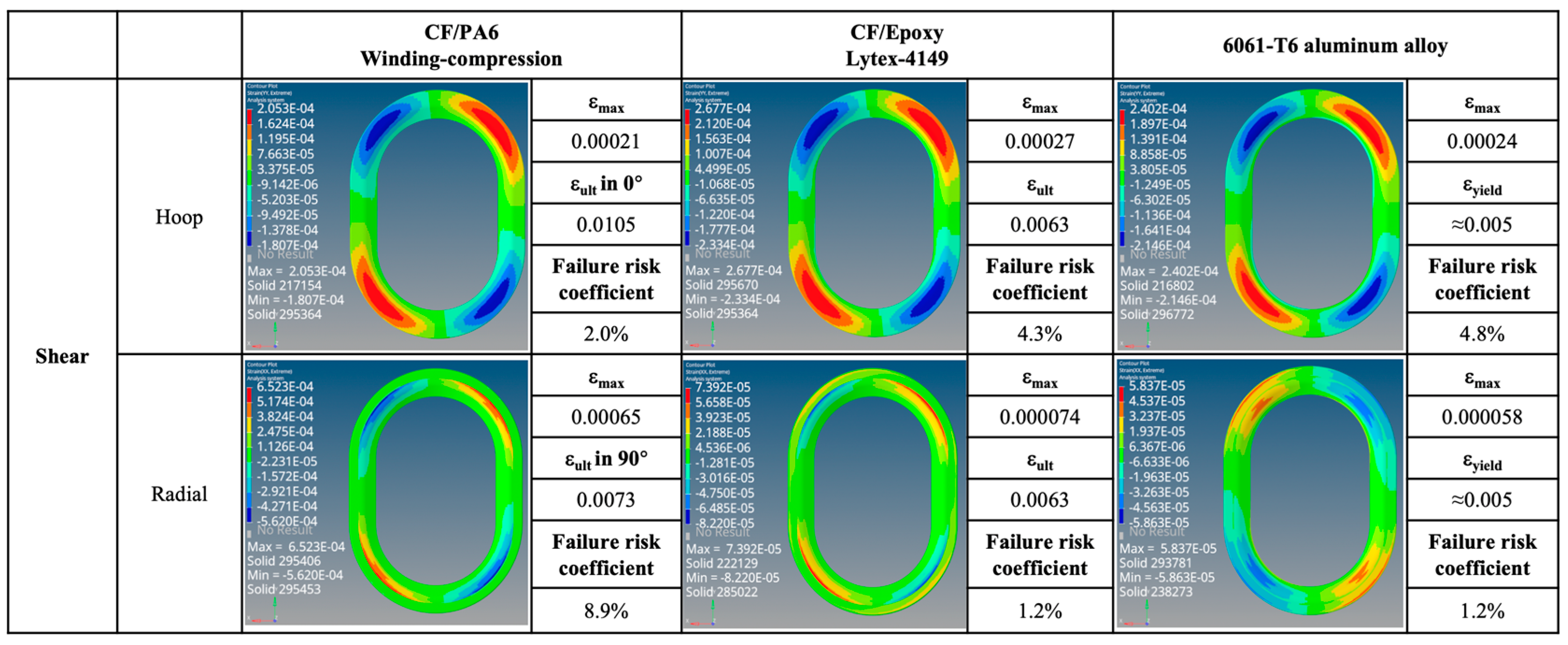
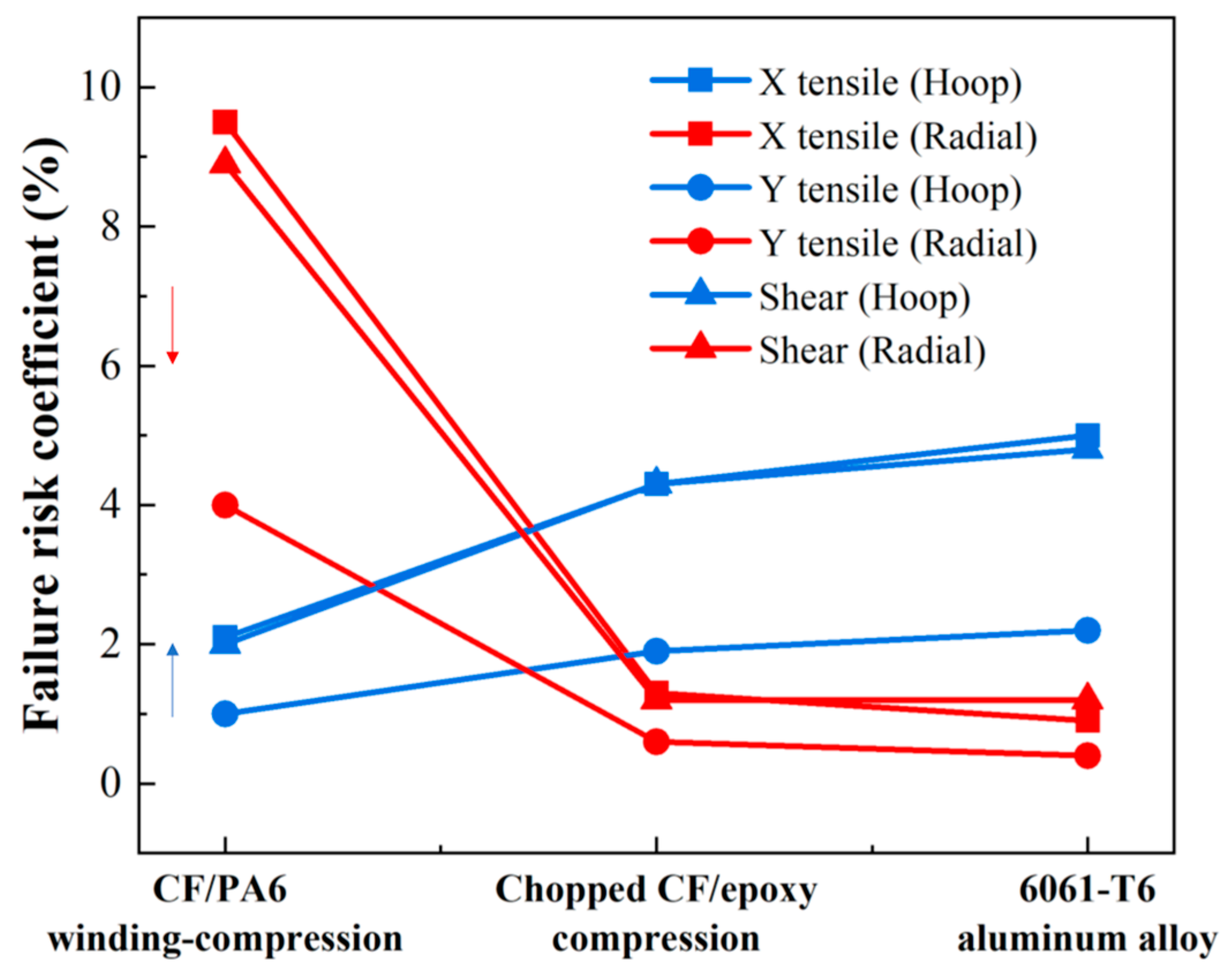
| Materials | E11 | E22 | E33 | γ12 | γ13 | γ23 | G12 | G13 | G23 | Density | Ultimate Failure Strain, εult |
|---|---|---|---|---|---|---|---|---|---|---|---|
| Units | GPa | GPa | GPa | GPa | GPa | GPa | g/cm3 | ||||
| UD T700/PA6 (40 vol.%) | 86 | 4.94 | 4.94 | 0.3 | 0.3 | 0.3 | 2.22 | 2.22 | 1.9 | 1.4 | 0.0105 (0°) 0.0073 (90°) |
| Chopped CF/epoxy Lytex-4149 | 34.5 | 34.5 | 8.6 | 0.3 | 0.3 | 0.3 | 0.82 | 0.82 | 0.33 | 1.48 | 0.0063 |
| 6061-T6 aluminum alloy | 70 | 0.3 | 2.7 | ≈0.005 (yield strain) [25] | |||||||
| Materials | E1 | E2 | E3 | γ1 | γ2 | γ3 | G12 | G13 | G23 | Ply Thickness |
|---|---|---|---|---|---|---|---|---|---|---|
| Units | GPa | GPa | GPa | GPa | GPa | GPa | mm | |||
| T800/Epoxy | 141 | 8.54 | 8.54 | 0.3 | 0.3 | 0.45 | 4.43 | 4.43 | 3.1 | 0.184 |
| No. of Specimen | 1 | 2 | 3 | 4 | 5 | 6 | Avg. |
|---|---|---|---|---|---|---|---|
| CF-T700SC (μm) | 7 | 7 | 7 | 7 | 7 | 7 | 7 |
| Monofilament fiber dosage | 36 k | 36 k | 36 k | 36 k | 36 k | 36 k | 36k |
| CF/PA6 filament diameter (mm) | 1.97 | 1.98 | 2.05 | 2.15 | 2.11 | 2.1 | 2.06 |
| Fiber volume content (vol %) | 46 | 45 | 42 | 39 | 40 | 40 | 42 |
| Density (g/cm3) | 1.32 | ||||||
| Porosity (%) | 6.38 (Density method determined) |
| Materials | T700/PA6 | Quantum Lytex-4149 CF/Epoxy | 6061-T6 Aluminum Alloy |
|---|---|---|---|
| Fiber-reinforced form | Continuous | Chopped | — |
| Fiber weight fraction (wt %) | 50 (weight-loss method) | 55 | — |
| Theoretical density (g/cm3) | 1.41 | 1.48 | 2.7 |
| 0° tensile strength (MPa) | 1357 | 217 | 303 |
| 0° tensile modulus (GPa) | 86 | 34.5 | 70 |
| 90° tensile strength (MPa) | 26 | 217 | 303 |
| 90° tensile modulus (GPa) | 4.9 | 34.5 | 70 |
| 0° compressive strength (MPa) | 378 | — | 303 |
| 0° compressive modulus (GPa) | 56 | — | 70 |
| 0° bending strength (MPa) | 733 | 531 | 303 |
| 0° bending modulus (GPa) | 80 | 31.7 | 70 |
| Interlaminar shear strength (ILSS) (MPa) | 65 | 44.8 | — |
| ±45° in-plane shear strength (MPa) | 35 | — | — |
| ±45° in-plane shear modulus (GPa) | 2.2 | — | — |
Disclaimer/Publisher’s Note: The statements, opinions and data contained in all publications are solely those of the individual author(s) and contributor(s) and not of MDPI and/or the editor(s). MDPI and/or the editor(s) disclaim responsibility for any injury to people or property resulting from any ideas, methods, instructions or products referred to in the content. |
© 2024 by the authors. Licensee MDPI, Basel, Switzerland. This article is an open access article distributed under the terms and conditions of the Creative Commons Attribution (CC BY) license (https://creativecommons.org/licenses/by/4.0/).
Share and Cite
Li, H.; Ge, Z.; Zhang, Y.; Zhang, B.; Wu, Y. Continuous CF/PA6 Composite Aircraft Window Frame Manufactured via a Novel Winding Compression Process. Materials 2024, 17, 1236. https://doi.org/10.3390/ma17061236
Li H, Ge Z, Zhang Y, Zhang B, Wu Y. Continuous CF/PA6 Composite Aircraft Window Frame Manufactured via a Novel Winding Compression Process. Materials. 2024; 17(6):1236. https://doi.org/10.3390/ma17061236
Chicago/Turabian StyleLi, Hongfu, Zengru Ge, Yanfei Zhang, Boming Zhang, and Ying Wu. 2024. "Continuous CF/PA6 Composite Aircraft Window Frame Manufactured via a Novel Winding Compression Process" Materials 17, no. 6: 1236. https://doi.org/10.3390/ma17061236






